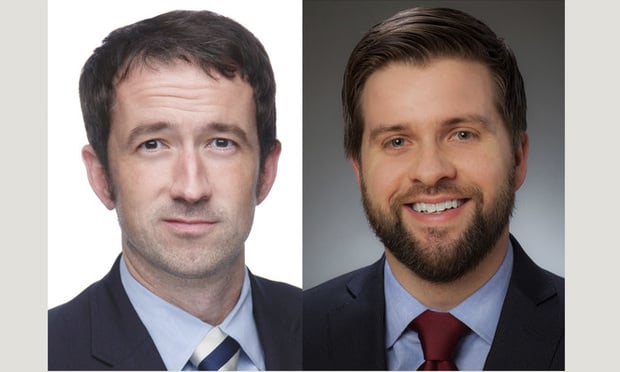Will Some Employers Be Allowed to Stop Offering Group Health Coverage Under the ACA? Stay Tuned
The new rules were proposed late last year by the U.S. Departments of Labor, Health and Human Services and Treasury. They would allow employers to set up HRAs to help their employees pay the premiums for health insurance policies within the individual marketplace in each state. If finalized, the change would let employers terminate group health plans and shift workers into the individual markets.
January 23, 2019 at 06:58 PM
7 minute read
 Finn Pressly, a shareholder with Littler Mendelson, left, and Nick Welle, counsel with Foley & Lardner. Courtesy photos.
Finn Pressly, a shareholder with Littler Mendelson, left, and Nick Welle, counsel with Foley & Lardner. Courtesy photos.
Proposed rules that would allow some employers to contribute funds to employee health reimbursement arrangements (HRAs) for purchasing individual health insurance instead of providing group health coverage are coming closer to reality, some labor and employment lawyers say.
The new rules were proposed late last year by the U.S. Department of Labor, Department of Health and Human Services, and the Treasury Department. They would allow employers to set up HRAs to help employees pay premiums for health insurance policies within the individual marketplace in each state. If finalized, the change would let some employers terminate group health plans and shift workers into the individual markets.
Separately, the Internal Revenue Service also issued a notice (2018-88) proposing safe harbors that would allow employers to satisfy the “employer mandate” provisions under the Affordable Care Act by funding HRAs for employees to buy health insurance, thereby avoiding severe tax penalties for noncompliance, according to the IRS notice of developing guidance, which is preliminary and is not binding.
“Theoretically, this would allow employers, for the first time ever, to fully satisfy the employer mandate without offering group major medical coverage to their employees,” said Nick Welle, senior counsel at Foley & Lardner in Milwaukee who advises clients on health benefits and regulatory compliance matters.
Finn Pressly, a shareholder at employment and labor firm Littler Mendelson in Chicago, said, “I am advising clients to watch this and think about this and whether this would make sense for them depending on their needs and their culture.” If enacted, the rules change would likely affect only smaller employers and those who employ part-timers, at first. “But it could be the first step in a very long road of employers getting out of the game,” Pressly acknowledged.
Currently it is a violation of the ACA for large employers to allow health reimbursement arrangements to be used to help pay workers' premiums instead of providing group health insurance. Under the ACA, large employers must offer affordable minimum essential coverage to 95 percent of employees in order to avoid penalties.
There is a limited small-employer exception that allows employers of fewer than 50 full-time employees or equivalents, who are not subject to the employer mandate and who don't offer any employees group health insurance, to use Qualified Small Health Employer HRAs to reimburse employees for individual health plan premiums. The proposed rule change would allow more employers to do this, but there would be additional requirements. The change would represent a significant shift in the employee benefit landscape for employers if it comes to pass, lawyers said. The public comment period ended Dec. 28.
“Under current ACA rules there is a blanket prohibition, which a lot of employers in the under-200 employee market were bummed about. They would rather have a defined-contribution approach,” Welle said.
The Trump administration under Executive Order 13813, issued in October 2017, proposed expanding the defined-contribution approach to employer health insurance coverage as part of an overall plan to repeal and/or replace the ACA and promote competition in U.S. health care. The proposals also included allowing association health plans and limited-duration, limited-benefit health plans. While legislation overturning the ACA seems dead, some rule-making continues.
Under the proposed HRA rules, employers generally would have to contribute a fixed amount into each individual HRA sufficient that any remaining premiums the employee would have to pay wouldn't exceed a percentage of his or her household income to be considered affordable under the employer mandate, in order to avoid penalties, Welle said.
If finalized, the new rules wouldn't take effect until Jan. 1, 2020, at the earliest. Welle said he believes that most large employers in the interim would probably continue to offer group health plans because they provide employers with a valuable recruitment incentive. In the latest statistics from Kaiser Family Foundation, roughly 16 million Americans were enrolled in the ACA marketplace or a Basic Health Program.
“Very large employers, sophisticated Fortune 500 companies are going to want to keep group health plans to attract and retain talent,” Welle said. “The individual market and the government exchange is just so much inconsistency with the switch from a Democratic to Republican administration, there are a lot of unknowns. The larger, sophisticated employers will say they are not comfortable telling their employees to go to the individual marketplace. I don't see changes for the large employers, the Fortune 500 types.
“But in the future, I see employers in the range of 50 to 200 employees who are burdened by the administrative responsibilities and the cost of administering health plans say this is a way they can do something for their employees but off-load some of the responsibilities. It is still developing and there is nothing to hang their hats on yet, but in 2021 or 2022 I can see the [smaller ones] saying this might be a good solution for us,” Welle said.
Pressly said the employers who right now are most interested in this are those with 50 to 100 workers and those who employ lots of part-time workers, as this could be a solution for providing coverage for them.
But for larger employers, he said, “it looks really appealing but the way the rules are written if you roll it out for one class of employees, you will have to push it to all employees in that class and the benefits vary wildly from state to state.”
Employers and employees might not fully grasp all the differences between the individual health insurance marketplaces in the states and its limitations, and employer-sponsored group health insurance coverage, Pressly said. Resistance could arise when top executives accustomed to group health plans' flexibility and coverage for expensive procedures such as in vitro fertilization encounter the limitations of many individual health insurance plans, including differences in what states require them to provide, he said.
In 2017, only 7 percent of the total U.S. population were in nongroup health insurance and 49 percent received employer-provided insurance. A combined 35 percent were on Medicaid or Medicare; 1 percent were on some other public plan and 9 percent were uninsured, according to the Kaiser.
Pressly said, “This goes hand-in-hand with state insurance markets and you really need to understand what that is, the cost and the coverage that is available to know what the ultimate employee experience is going to look like.”
Some of the hundreds of commenters on the notice of proposed rule making by the IRS, Employee Benefits Security Administration and HHS filed Oct. 29 in the Federal Register included state public health plans, a public employees organization, unions, a global risk management, advisory and insurance brokerage firm, and think tanks, the National Federation of Business, National Association of Dental Plans, American Benefits Council, and individual health care providers. The comments period is now closed.
This content has been archived. It is available through our partners, LexisNexis® and Bloomberg Law.
To view this content, please continue to their sites.
Not a Lexis Subscriber?
Subscribe Now
Not a Bloomberg Law Subscriber?
Subscribe Now
NOT FOR REPRINT
© 2025 ALM Global, LLC, All Rights Reserved. Request academic re-use from www.copyright.com. All other uses, submit a request to [email protected]. For more information visit Asset & Logo Licensing.
You Might Like
View All
Fired by Trump, EEOC's First Blind GC Lands at Nonprofit Targeting Abuses of Power
3 minute read
Trump Fires EEOC Commissioners, Kneecapping Democrat-Controlled Civil Rights Agency


The New Trump Worksite Enforcement Paradigm: Everything You Need to Know
14 minute readTrending Stories
- 1Google Makes Appeal to Overturn Jury Verdict Branding the Play Store as an Illegal Monopoly
- 2First Amendment Litigator Returns to Gibson Dunn
- 3In Record Year for Baker Botts, Revenue Up 11.8%, PEP Up 17.6%
- 4Loopholes, DNA Collection and Tech: Does Your Consent as a User of a Genealogy Website Override Another Person’s Fourth Amendment Right?
- 5Free Microsoft Browser Extension Is Costing Content Creators, Class Action Claims
Who Got The Work
J. Brugh Lower of Gibbons has entered an appearance for industrial equipment supplier Devco Corporation in a pending trademark infringement lawsuit. The suit, accusing the defendant of selling knock-off Graco products, was filed Dec. 18 in New Jersey District Court by Rivkin Radler on behalf of Graco Inc. and Graco Minnesota. The case, assigned to U.S. District Judge Zahid N. Quraishi, is 3:24-cv-11294, Graco Inc. et al v. Devco Corporation.
Who Got The Work
Rebecca Maller-Stein and Kent A. Yalowitz of Arnold & Porter Kaye Scholer have entered their appearances for Hanaco Venture Capital and its executives, Lior Prosor and David Frankel, in a pending securities lawsuit. The action, filed on Dec. 24 in New York Southern District Court by Zell, Aron & Co. on behalf of Goldeneye Advisors, accuses the defendants of negligently and fraudulently managing the plaintiff's $1 million investment. The case, assigned to U.S. District Judge Vernon S. Broderick, is 1:24-cv-09918, Goldeneye Advisors, LLC v. Hanaco Venture Capital, Ltd. et al.
Who Got The Work
Attorneys from A&O Shearman has stepped in as defense counsel for Toronto-Dominion Bank and other defendants in a pending securities class action. The suit, filed Dec. 11 in New York Southern District Court by Bleichmar Fonti & Auld, accuses the defendants of concealing the bank's 'pervasive' deficiencies in regards to its compliance with the Bank Secrecy Act and the quality of its anti-money laundering controls. The case, assigned to U.S. District Judge Arun Subramanian, is 1:24-cv-09445, Gonzalez v. The Toronto-Dominion Bank et al.
Who Got The Work
Crown Castle International, a Pennsylvania company providing shared communications infrastructure, has turned to Luke D. Wolf of Gordon Rees Scully Mansukhani to fend off a pending breach-of-contract lawsuit. The court action, filed Nov. 25 in Michigan Eastern District Court by Hooper Hathaway PC on behalf of The Town Residences LLC, accuses Crown Castle of failing to transfer approximately $30,000 in utility payments from T-Mobile in breach of a roof-top lease and assignment agreement. The case, assigned to U.S. District Judge Susan K. Declercq, is 2:24-cv-13131, The Town Residences LLC v. T-Mobile US, Inc. et al.
Who Got The Work
Wilfred P. Coronato and Daniel M. Schwartz of McCarter & English have stepped in as defense counsel to Electrolux Home Products Inc. in a pending product liability lawsuit. The court action, filed Nov. 26 in New York Eastern District Court by Poulos Lopiccolo PC and Nagel Rice LLP on behalf of David Stern, alleges that the defendant's refrigerators’ drawers and shelving repeatedly break and fall apart within months after purchase. The case, assigned to U.S. District Judge Joan M. Azrack, is 2:24-cv-08204, Stern v. Electrolux Home Products, Inc.
Featured Firms
Law Offices of Gary Martin Hays & Associates, P.C.
(470) 294-1674
Law Offices of Mark E. Salomone
(857) 444-6468
Smith & Hassler
(713) 739-1250






